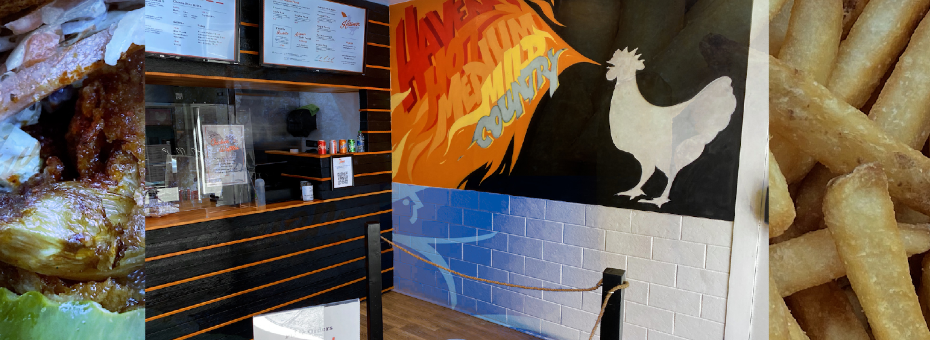During a recent LEI webinar, my ears perked up when Karen Gaudet was introducing the featured guests, who would bring to life their bootstrapping ethos of “reaching for their minds before reaching for their wallets.” Co-founders Etkin Tekin and Rob Latronica of Haven Hot Chicken (HHC), a startup quick-service restaurant (QSR), discussed launching a business in the middle of a pandemic in the industry hardest hit by its knock-on effects.
At a time when many of us are starting up this and that with limited resources, figuring out what features to add to existing products or services, or what products or services to introduce, or what businesses to create, I recognized their story contained valuable lessons for any business and decided to pass it along to you. Not only could Rob and Etkin articulate how they developed their company’s value proposition, but they also had a method for figuring out how to create and deliver it. It’s not perfect, and they would not claim otherwise, but I think it is worth considering it for your startup challenges.
What Is Value, Exactly, and Quality?
To specify value, the first and foremost lean principle, Etkin, Rob, and the other two co-founders used Bain & Company’s “Elements of Value Pyramid.” They wanted more to work with than the simple idea that value is whatever customers are willing to pay for. The Pyramid’s originators see it as a heuristic framework that organizes 30 elements hierarchically. Functional (e.g., saves time, connects) elements form the base, emotional (e.g., entertainment) and life-changing (e.g., motivation) fill out the middle, and social impact (e.g., self-transcendence) sits on top.
Utilizing a kaizen mindset for a unique situation with real constraints can help mitigate risk through careful planning.
As a startup, they did not yet have any customers. So, they began with an internal survey to see which half dozen or so elements the team intended to deliver. (According to Bain’s research, consistent delivery of four of the elements can lead to four times greater revenue growth. World-class companies – Apple, Nike – are recognized by their customers for delivering eight to eleven.) The exercise revealed popular and consensus elements among the HHC team. Differences of opinion were exposed too. But now, at least, they were on the same page. Of the seven elements they agreed on delivering, quality would be number one. The other elements would be saves time, fun, belonging, and a few more.
The Pyramid had given them clarity, a common language, by breaking down the value proposition into discrete elements. When they would eventually have customers, survey questions around each of the elements could reveal more specific problems to solve. In other words, they were setting themselves up for ongoing improvement.
After the webinar, I also learned how they came to define quality, a product attribute that can be hard to pin down, much less to define quantitatively. HHC’s main product is spicy fried chicken, seasoned and prepared “Nashville-style.” Today, 60% of their sales come from “THE Sandwich” with chicken, slaw, pickles, and the “Rob sauce” on a toasted bun. When I went to New Haven, CT, where HHC is based, to try out the product for myself (although I ordered the “Not Chicken Sandwich” as a vegetarian, with cauliflower steak as the substitute), I was told to enjoy my “crispy, crunchy, spicy, juicy, delicious” meal. It struck me how measurable those attributes could be.
How and When Does Value Show Up?
Next, one by one, they dove deeply into the question, “How does ‘X’ [element of value] come to life?” For example, belonging, and its complement inclusiveness, led them to source halal chicken. They knew this would greatly expand their potential customer base given local demographics. Inclusiveness also led them to put products for kids (e.g., mac and cheese) on their very limited menu. Doing so would allow “hot heads” – customers who like extremely spicy food – to bring their families.
Concurrently, they drew out the “customer journey,” starting when someone gains awareness of the company. Service, the stage in the journey when value is really delivered, was broken down into discrete steps:
This helped them identify specific moments when, and ways in which, value could be delivered. Based on that, they could and did begin defining the delivery processes and actual work.
Chef Rob talks about using work analysis, design, and improvement tools such as spaghetti maps, process study sheets, and ERACS (Eliminate-Rearrange-Add/Subtract-Combine-Simplify) which is derived from Training Within Industry’s (TWI) Job Methods. As these tools helped them question every detail, such as whether to toast the bun or place down the wrapper first, they kept asking themselves, “How does this action add value to the customer?” If it didn’t, they did all they could to eliminate it.
I should note here that HHC’s co-founders have ambitions to scale the concept, opening stores throughout Connecticut and beyond. And so, as they were designing the work, they were thinking about how to make it repeatable too, and easily trainable. They created Job Instruction Sheets for that purpose. Moreover, with scaling in mind, they analyzed process capacity, especially around chicken sandwiches, when designing the layout and selecting equipment. This ended up saving the first store $11,000 with a smaller-than-planned fryer based on their understanding of the overall system’s capacity: a 34-second line-off, or delivery, rate. With plans to open many more stores, saving $11,000 on every additional fryer is expected to really add up.
But Will It All Work for Real?
Finally, they were ready and eager to test out their hypotheses. For that, they turned to the Lean Startup idea of a minimal viable product (MVP). But in their case, it was more of a minimal viable business manifest through a series of “pop-ups” – fully-functional operations open for a few hours in a rented space (e.g., an existing restaurant). Going into these pop-ups, they had a set of questions that needed answers: Could they deliver their intended value? Was that the value customers actually desired? How effective was the work of delivering it?
The pop-ups made tangible a few core lean ideas: one-piece flow makes work easier and pull-based replenishment enhances quality and saves time.
It’s worth noting that typical means of defining the “voice of the customer” were hard to pin down at that time. While Chef Rob’s culinary expertise allowed them to define quality to a degree, they could only guess how many customers they’d need to serve in a given timeframe (i.e., estimate takt time). They also did not know exactly when customers would arrive and what those customers would order – the product mix. Of course, the HHC team could and did make predictions for these things for their operational usefulness (e.g., setting a pace and distributing work).
When it launched in October 2020, the first pop-up drew tons of interest. Nashville-style hot chicken, popular elsewhere, had not been available in New Haven before. Lines formed. After a few pop-ups, feedback was showing recognition for the delivery of sensory appeal (functional) and even affiliation/belonging (life-changing) by way of this delicacy from afar (well, Nashville), heretofore a scarcity. Customers were also recognizing quality (functional), even if saving time (functional) was harder to achieve. As you might predict, the pop-ups kept revealing a lot of operational debugging to do.
Among other things, the pop-ups made tangible a few core lean ideas: one-piece flow makes work easier and pull-based replenishment enhances quality and saves time. HHC’s lean coaches, Steve Crowley and Brian Reece of Service Physics, had been advocating for one-piece flow all along, but to little avail. The idea was too counterintuitive. Until, that is, the HHC team, especially Chef Rob, tried it during one of the pop-ups. He and the line cooks were astonished by how much easier the work became. The elimination of batching, and a simple two-bin replenishment scheme, freed up workspace and mindshare to focus on quality. And the fact that customers were getting fresher – dare I say crispier, crunchier, juicier, spicier, and more delicious products – at a consistent pace with less waiting was better too.
Now Go Try for Yourself
All in all, I was impressed by the HHC team’s effort given the rigor and attention to detail involved in their set-up. Moreover, I appreciated the risk mitigation through careful planning and the use of pop-ups, and how all of it was done on the cheap. To me, it’s a good example of utilizing a kaizen mindset for a unique situation with real constraints. Again, their method is not perfect. No method is. But they have one, and it’s working, which is to say they’re learning and improving. With limited resources, an ongoing pandemic, and ambitions to scale, what else could you ask for?
Virtual Lean Learning Experience (VLX)
A continuing education service offering the latest in lean leadership and management.






